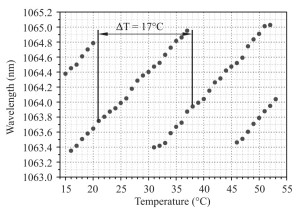The laser I’ve bought for my DIY Raman spectrometer is *cheap* and therefore probably not very good. To compensate for this I’ve (without thinking) put a narrow 2 nm bandpass filter between the laser and the rest of the optical path, the excitation wavelength is at it’s worst thus 532 ±1 nm.
The wavenumber of a Raman signal is related to the excitation wavelength (λ₀) and the wavelength of the Raman-scattered light (λ₁) as follows:
A Stokes line at 1650 cm⁻¹ will have a wavelength of 583.2 nm if the excitation wavelength is 532 nm. However λ₀ = 532 ±1 nm, so λ₁ = 583.2 ±1.2 nm. This may at first seem insignificant, but the result is that a signal in the Raman spectrum at 1650 cm⁻¹ will be spread over an interval of 1614-1685 cm⁻¹.
My spectra will be clear as the Mississippi River!
..this was worst case, how bad is it then likely to be?
Laser diodes exhibit a significant spread in emission wavelength,¹ so it makes sense to use a diode pumped solid state laser aka a 532 nm DPSS laser module as this should give a clean 532 nm.
Essentially a 532 nm DPSS laser module consists of an 808 nm laser diode pumping an Nd:YAG or Nd:YVO₄ rod which itself emits at 1064 nm because of the Nd³⁺ ions. The output at 1064 nm is sent through a non-linear optical material and frequency doubled to the desired 532 nm.²
The emission line at 1064 nm in an Nd:YVO₄ crystal is unfortunately not really a single line and it’s drifting with temperature.³ The following figure is taken from the article by J.Z. Sotor and shows the different wavelengths emitted as a function of the temperature:
Apparently I can expect at least two wavelengths for any given temperature within the working range of my cheap laser. However, after a quick inspection of the heatsink and Peltier element, I think it’s safe to say that I’ll have no guarantee what so ever that the laser module is maintained at anything resembling a constant temperature.
In other words, I need a laser that operates in single longitudinal mode.
¹ Sam’s laser FAQ – Diode lasers
² Sam’s laser FAQ – Solid state lasers
³ Single-longitudinal mode Nd:YVO4/YVO4/KTP green solid state laser
J.Z. Sotor, A.J. Antończak, K.M. Abramski, Opto-Electronics Review 2010, 18, 1, pp 75-79

Very nice post. I simply stumbled upon your blog and
wanted to mention that I have really loved browsing your
blog posts. After all I will be subscribing
for your feed and I’m hoping you write again soon!
LikeLike
Thankyou for the kind words 🙂
LikeLike